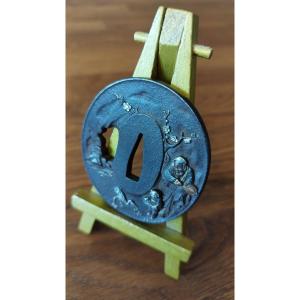None of these officer's daggers have ever been the subject of a regulation, although they have a "family resemblance" between them. The details vary, depending on the fortune and taste of the officer
. In fact, the Emperor had even, by letter to the minister dated October 5, 1807, forbidden the wearing of daggers by officers of his Navy. This apparently followed an unfortunate incident involving Lieutenant Charles Moreau, second in command of "la Piémontaise" who allegedly stabbed the British Captain Larkins of the" Warren Hastings", a ship of his majesty, on June 21, 1806, involuntarily or not, while this officer had already surrendered.
Since the prohibitions were not always respected, these daggers existed and were frequently worn despite the Emperor's wishes.
BLADE: It has a triangular section with 3 hollow sides. On the first third, there are engravings: On the 2 small faces, we can recognize a trophy of arms On the large face, an inscription that I cannot decipher. Length of the blade = 35.8 cm, width near the guard 1.7 cm, thickness near the guard 8.4 mm
GUARD: It is made of brass, with 2 quillons curved towards the blade, and has in its middle the representation of an anchor without its rope, which is characteristic of the period.
HANDLE: it is made of very finely engraved horn and ends on the side of the guard with a chiseled brass ferrule, and on the opposite side with a cap forming the pommel, on which the tang of the blade is riveted.
SCABBARD: it is made of leather, triangular in shape. Scabbard entrance and rivet are in gilded brass. Shell-shaped attachment tab characteristic of naval weapons, at the level of the chape.
This is a beautiful elegant object, in good condition at a reasonable price.
Ref C-2454
Shipping costs France 20€, Europe 30€





























 Le Magazine de PROANTIC
Le Magazine de PROANTIC TRÉSORS Magazine
TRÉSORS Magazine Rivista Artiquariato
Rivista Artiquariato
